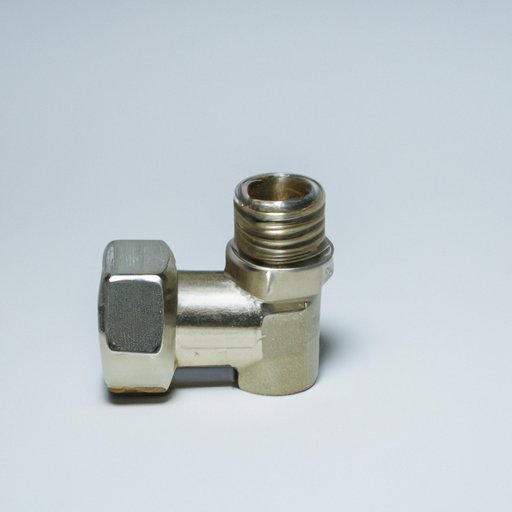Introduction
Compression fittings are a type of connector that allow two pipes or hoses to be connected together. They are commonly used in plumbing applications due to their ease of installation and ability to create flexible connections. Compression fittings are available in a variety of materials including copper, steel, and brass.

Benefits of Using Compression Fittings
Compression fittings offer a number of advantages over other connection types:
Easy Installation
Compression fittings can be installed quickly and easily with minimal tools or experience. All that is required is a wrench or spanner to tighten the nut. This makes them ideal for DIY projects or maintenance work.
Flexible Connections
Compression fittings create flexible connections between pipes or hoses, which allows for movement without compromising the integrity of the connection. This makes them ideal for use in areas where there is vibration or movement.
Versatility
Compression fittings are widely available in a variety of sizes and materials, making them suitable for a range of applications. They are also easily adaptable to different pipe diameters.
Step-by-Step Guide to Installing Compression Fittings
Installing compression fittings is a relatively straightforward process. Follow these steps to ensure a secure and reliable connection:
Gather Necessary Tools and Materials
To install compression fittings, you will need a wrench or spanner, thread sealant, and the appropriate length of pipe. Check the manufacturer’s instructions for details on the size and type of pipe that is compatible with your fitting.
Cut the Pipe to the Correct Length
Using a pipe cutter, cut the pipe to the correct length as specified by the manufacturer. If necessary, use a file or sandpaper to smooth any rough edges.
Deburr the Pipe
The next step is to deburr the end of the pipe to remove any sharp edges. This will help to ensure a secure fit when the pipe is inserted into the fitting.
Apply Thread Sealant
Thread sealant helps to protect the connection from leaks. Apply a small amount of thread sealant to the threads of the fitting before assembly.
Assemble the Fitting
Insert the pipe into the fitting until it reaches the stop inside the fitting. Make sure that the pipe is fully seated in the fitting.
Tighten the Nut
Using a wrench or spanner, tighten the nut until it is securely in place. Do not overtighten as this could damage the fitting.

Types of Compression Fittings and their Applications
Compression fittings are available in a variety of materials, each with its own unique properties and applications.
Copper Compression Fittings
Copper compression fittings are highly resistant to corrosion and have excellent thermal conductivity, making them ideal for use in hot water systems. They are also cost-effective and easy to install.
Steel Compression Fittings
Steel compression fittings are strong and durable, making them suitable for high-pressure applications. They are often used in hydraulic systems and are available in a variety of sizes and shapes.
Brass Compression Fittings
Brass compression fittings are resistant to corrosion and are ideal for use in low-pressure applications. They are inexpensive and easy to install, making them a popular choice for plumbing applications.

Common Problems with Compression Fittings and How to Resolve Them
Compression fittings are generally reliable and durable, but there are a few common problems that can arise:
Leaks
Leaks can occur if the fitting is not properly sealed. To fix this, make sure the pipe is fully seated in the fitting and that the nut is properly tightened. Additionally, check for any gaps or cracks in the pipe or fitting.
Corrosion
Corrosion can cause the fitting to become brittle and weak, leading to leaks and other issues. To prevent this, make sure the fitting is made of the appropriate material for the application and keep an eye out for signs of corrosion.
Inadequate Sealing
If the fitting is not properly sealed, it can lead to leaks or other issues. To ensure adequate sealing, use a thread sealant and make sure the pipe is fully seated in the fitting.
Troubleshooting Tips for Compression Fitting Installation
Compression fittings are generally easy to install, but there are a few things to keep in mind to ensure a secure and reliable connection:
Check for Proper Fit
Make sure the pipe is the right size and shape for the fitting. If possible, use a caliper to measure the diameter of the pipe and compare it to the manufacturer’s specifications.
Use the Right Tools
Using the wrong tools can damage the fitting or pipe. Make sure to use the proper wrench or spanner when tightening the nut.
Follow Manufacturer Guidelines
Check the manufacturer’s instructions for any special requirements for installation. This will help to ensure that the fitting is installed correctly and securely.
Conclusion
Compression fittings are a reliable and easy-to-install solution for connecting pipes and hoses. They offer a number of benefits such as easy installation, flexible connections, and versatility. There are a variety of types of compression fittings available, each suited to different applications. Common problems such as leaks, corrosion, and inadequate sealing can be avoided by following the manufacturer’s guidelines and using the right tools. With a little bit of knowledge and preparation, installing compression fittings can be a simple and effective way to complete your next plumbing project.
(Note: Is this article not meeting your expectations? Do you have knowledge or insights to share? Unlock new opportunities and expand your reach by joining our authors team. Click Registration to join us and share your expertise with our readers.)
